Texto publicado em português originalmente no dia 6 de agosto de 2013.
‘I am from Northeast. And if there’s something that someone from that region does all the time is changing from right to not so right.’ The quote from Severino do Quixadá, Renato Aragão’s role, when he talks to the Witch Fairy, played by Bruna Lombardi in O Cangaceiro Trapalhão, released 31 years ago, is a good example how the Brazilian comedy blockbuster had, in higher or lower degree, an acute view on the Brazilian’s economic status. Coincidently, it’s in the Northeast the best movies of Didi, Dedé, Mussum and Zacarias take place. Among outlaws and street entertainers, vagabonds and gold hunters, the Trapalhões helped to form Brazilian generations, either in crowded movies or in front of the TV screen. From now on, I list my troupe’s favorite movies which cannot be separated from my childhood as much as the whole country’s childhood.

10 The Trapalhões in the Planets’ War
[Os Trapalhões na Guerra dos Planetas, Adriano Stuart, 1978]
One of the most Brazilian all time’s shamelessness movies, The trapalhões in the Planets’ war is a Star Wars copy-cat, that sucks in the characters’ visual such as Darth Vader, Luke Skywalker and Chewbacca to a prince’s tale stared by Pedro Aguinaga – at that time, he was elected the most handsome man in Brazil – who lands on Earth to get help to face enemies in his native planet. It was one of the five movies directed by Adriano Stuart. The visual effects and the art direction are quite bad, which gave the movie an trash-cult aura, that went far beyond Brazilian borders as the Brazilian Star Wars. Maybe because of the low budget, the movie has several scenes without a single dialogue. Long scenes where people stage fights, dance or whatever. The electronic sound track in the Giorgio Moroder style helps to move the story forward, creating a few hypnotic moments that make believe the movie is more interesting than it is really. In the same mood, TV hostess Christina Rocha makes an entrée, without any purpose or any line.
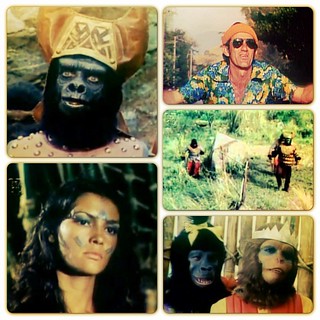
9 The Trapalhão in the Ape’s Plateau
[O Trapalhão no Planalto dos Macacos, J.B. Tanko, 1976]
A more careful production on one side; on the other hand, less ambitious. It turns out to be another American blockbuster’s sarcastic copy-cat. (By the way, it copies two blockbusters at the same time since the opening scene is a – delicious – joke on Steven Spielberg’s Jaws). Here, at least, there is some concern to put Brazilian reality in the spotlight. Renato Aragão e Dedé Santana’s characters are mistaken by thieves and, along with the cop who chases them, stared by Mussum, in his Trapalhões’s debut, enter in a balloon that travels to a planet conquered by apes. The low budget costumes and make-up give the movie a craft stroke that works just fine so the Trapalhões present their gags, which gave the movie some international fame as a cult and trash piece of art.
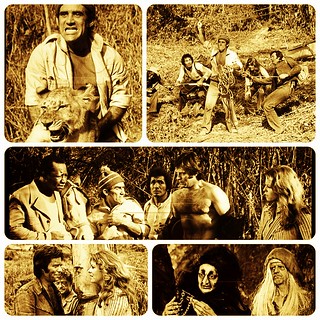
8 The Trapalhão in the King Solomon’s Mines
[O Trapalhão nas Minas do Rei Salomão, J.B. Tanko, 1977]
The biggest Trapalhões’ blockbuster had not yet the presence of the ‘mineiro’ Zacarias, but had a lot to say on how the group would work together. The plot unfolds as the three protagonists apply stings, make-shift quarrels to make money with the bets. In a single package, the Trapalhões reflected the ‘jeitinho brasileiro’(the Brazilian lifestyle), as they philosophize about the economic hardship which would force the population to struggle to make the ends meet. In fact, this would become a group’s trade mark. What comes next is one more screenplay the group made of a legendary character or story, a little more simple, but with delicious moments, such as the scenes the trio meets the witch played by Vera Setta, who became a nightmare for an entire Brazilian generation.

7 The Cinderella Trapalhão
[O Cinderelo Trapalhão, Adriano Stuart, 1979]
The final scene is a classic of the afternoon sessions: every ‘trapalhão’ gets a portion of land as a reward for having saved a farm to a cowboy, but Cinderelo, Renato’s character, gets the smallest share. When he digs in his small yard, to bury the shit from his goat Gumercindo, he finds oil, the black gold . Everyone cheers and the movie ends with the frozen image of the Trapalhões, jumping with joy. It is the end, The Trapalhões poke the Brazilian feudal society, which crackdowns on the working class by force. There are a lot of funny scenes, especially when Renato Aragão plays an Arabic prince and Dedé pretends to be an Mexican. Dino Santana, Dedé’s brother, plays along with him an acrobatic and magnificent fight.

6 The Trapalhões in Serra Pelada
[Os Trapalhões na Serra Pelada, J.B.Tanko, 1982]
The first Trapalhões movie I watched in a movie theather and, possibly, my first expericence before the big screen, is an irregular movie, which begins very well, exploring an essencial subject at the time in Brazil, the gold mining, showing the quartet had a close interest in Brazilian history. The movie balances between one of the best movie’s sound tracks with an interesting portrait of the human anthill, but the script varies to a more common adventure which, despite showcases the gold mining’s power, targets long fights sometimes played by the army, which gives an official tone to the movie, and ranks the trio way below the rest. The music stands out above the group. Procurei Teresa,(I looked for Teresa) sung by Didi and Dedé and , and “Perdi Minha Nega num Forró″,(I lost my girl in the ball room) wonderful performance of Zacarias (both in the sequence with the participation of the brilliant instrumentist Sivuca and a feminine chorus) are genious.

5 The Vagabond Trapalhões
[Os Vagabundos Trapalhões, J. B. Tanko, 1982]
Strongly inspired by Charles Chaplin’s vagabond, Renato Aragão again gives name to a character of his own, a homeless called Bonga(the other was Bonga’s protagonist, the Vagabond, when the Trapalhões had not born yet). The outcome, in J.B. Tanko’s hands, has a remarkable popular lirism, backed by the lyrics co-written by Aragão. The plot, in the instrumental version that opens and ends the movie or the one sung by Jessé, is pretty and helps to create the melancholic movie tone, providing the background to the quartet’s touching stories. Louise Cardoso, very young, is pretty and she is one the few girls to finish the story seduced by an Aragão’s character, even though his real crush was Denise Dumont. Fabio Villa Verde and Isabela Bicalho, (famous for her Narizinho nickname) are among the story’s children.

4 The Outlaw Trapalhão
[O Cangaceiro Trapalhão, Daniel Filho, 1983]
This is probably, in the Trapalhões’s filmography, the best directed movie, tributary to a tipically Brazilian gender, the ‘cangaço’(outlaws that terrorized Brazilian Northeast in the 20’s and 30’s). In the opening sequence, when a town is ambushed, Daniel Filho displays his abilities as a movie maker, directing actors and cameras on the rooftops, taking advantage of cranes and looking for the most interesting angles under which the quartet was framed. It is by far the movie with the best performance of guest actors invited by the group, with a special highlight to Nelson Xavier who plays Lampião and Tania Alves, as Maria Bonita. Tânia, by the way, lends her voice to one of the movies’s song, one more nice sound track signed by Guto Graça Mello. The best musical moment is the anthological “Lagartixa, by Rita Lee, that provides the atmosphere to the date between Severino do Quixadá (Renato Aragão) and the Witch Fairy Bruna Lombardi. The dialogues, way above the Trapalhões’s average, owe their brilliancy to the great Chico Anysio. Regina Duarte, in her probably single role in a motion picture, is the ‘mocinha’ (the principal female character of a story, play etc).
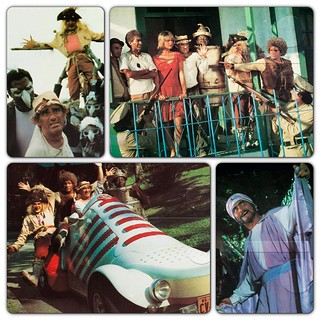
3 The Trapalhões and the Wizard of Oróz
[Os Trapalhões e o Mágico de Oróz, Dedé Santana & Victor Lustosa, 1984]
This the movie that brings back the Trapalhões after a six-month break-up. The direction was shared by Dedé Santanha and Victor Lustosa. The outcome is a surprising mixture of Wizard of Oz’s phantasy with a sharp social criticism, in which the quartet represents the ‘nordestino’(a person who is born in the Brazilian Northeast) in his struggle to survive, right in the middle of the drought-stricken backland. Arnaud Rodrigues’s repertoire, as much as the Victor Fleming’s movie, helps to create the link both with the fairy tale and the story’s political agenda. It is one of the most serious group’s movies, even though there is plenty of room for gags and puns; besides, it has one of the best well finished Trapalhões’ scripts, a screenplay even better than the ‘Oz’ carried out by Motown in 1978. The sentence that ends the movie says a great deal about its nature. “ It rained. May the rain that wet the Northeast’s miserable land not cool our authorities’s enthusiasm in the search for solutions to the drought.”
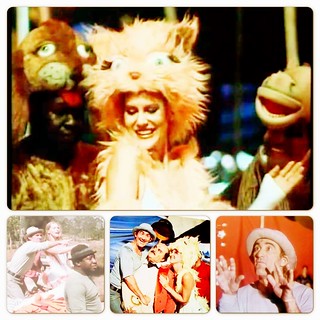
2 The Juggler Trapalhões
[Os Saltimbancos Trapalhões, J. B. Tanko, 1981]
The symbol-movie for a whole generation and for the Trapalhões’ career themselves, a favorite among almost every kid in the 80’s, this movie fails only in the editing. The sequences are confused and especially careless between scenes and the musical performances are blocked, instead of a more pleasant distribution along the plot. However, watching Os Saltimbancos Trapalhões is a magical experience. Renato Aragão dreamed about this movie as his masterpiece and asked Chico Buarque to adapt his play to the movie theater. Chico not only authorized the screenplay(already a version from an Italian musical), but did write a brand new script and new songs for the movie. Pretty songs such as “Hollywood” (in the soft Lucinha Lins’s voice), “Piruetas” and “Alô, Liberdade” take the fight for power universe to the world of circus, a perfect stage for four clowns. The physical humor achieves anthological levels, such as “vou popotizar você”, with an inspired Didi, or when Zacarias and Mussum are chased by the dog Bob. J.B. Tanko balances lyrism, adventure and even a psychodelic visit to a movie studio in a simple plot as to show how the blue collar can get to the power.
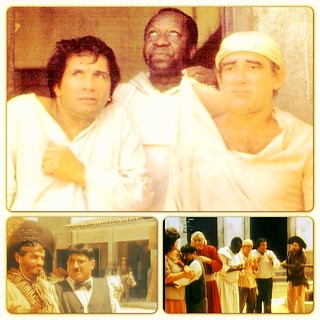
1 Os Trapalhões in the Auto da Compadecida
[Os Trapalhões no Auto da Compadecida, Roberto Farias, 1987]
A single encounter between the Trapalhões and the movie maker Roberto Farias came up with the best group’s job. As other movies failed in the editing and timing, this one, based on the Adriano Suassuna’s classic, is impeccable, almost a master piece, that owes nothing to the 2000 Guel Arraes’s version. Renato Aragãos plays João Grilo and Dedé Santana is Chicó. Both are inspired. Farias, who signs also the scriptwriting, produced an sharp text, quite loyal to the original, which captures the Northeast’s poetry, translates its characters and its nature. It is an movie with plenty of local accent yet universal. Zacarias plays the little market’s owner, changing his traditional role. Mussum stands out as the monk who takes an important role in the end. Suassuna, by the way, thinks this has been the best matching in the big screen for his play. The cast, with highlights to Claudia Gimenez, José Dumont and Raul Cortez, works just fine in a performance hard to find. Antônio Madureira’s sound track gives unity to all sequences, the final as well, when the trial in heaven becomes a circus, an ideal place where the Trapalhões feel at home.
A delicious movie.
Now it is your turn to leave a few words about your list of favorite Trapalhões’s movies.
Tradução do original escrito por mim feita pelo meu amigo Jorge Valente, que aceita encomendas pelo email: jorge_valente@uol.com.br.

Chico, já havia visto a lista no ano passado, mas nunca é demais rever. Sessão nostalgia forte.
O Cangaceiro Trapalhão tem cenas das quais nunca me esqueci. É de fato um filme muito bem dirigido pelo Daniel Filho. A cena da Bruna Lombardi é antológica.
Não está na lista, mas um dos filmes da trupe que mais marcou minha infância foi “Os Trapalhões no Rabo do Cometa”, mistura de filme com animação, que vi dezenas de vezes na infância (o fato do meu pai ter tido uma videolocadora ajudou muito), mas nunca mais revi e muito menos achei por aí. Talvez visto hoje, seria uma experiência deliciosamente “retrô”.
Também gostava muito de “Os Fantasmas Trapalhões” (com Gugu Liberato como “galã”), que hoje deve ter envelhecido.
Sou de uma geração que pegou a fase “final” dos Trapalhões no cinema, no começo dos anos 90, com filmes como “Os Trapalhões e a Fonte da Juventude”.